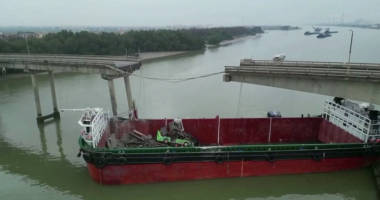COVID case rates are falling in half of local authorities in England, data reveals.
The interactive map below shows the rate per 100,000 people in your area, based on the UK data from the Government coronavirus dashboard.
Click here to see the interactive map.
Analysis of authorities in England by PA news agency further confirms a drastic drop in Covid cases in the past week or so.
The figures, for the seven days to July 22, are based on the number of people who have tested positive for Covid with either a PCR or lateral flow test.
Of the 315 local areas in England, 177 (56 per cent) have seen a fall in new cases per 100,000.
Some 136 (43 per cent) have seen a week-on-week rise and two are unchanged.
It’s a drastic change in direction, considering on Friday, PA reported that 307 (97 per cent) of England’s local authorities had rising case rates in the week to July 19.
It comes as the number of new Covid cases reported by the Department of Health has fallen for the sixth day in a row.
The UK recorded a further 24,950 Covid cases yesterday, down from the 46,558 reported on July 20.
Graphs show the sudden drop in infections from a “peak” on 16 July. But it’s not clear yet if this trend will continue.
🔵 Read ourcoronavirus live blog for the latest updates
Experts have speculated a number of reasons for declining cases, including warm weather that drives people outdoors, and less people coming forward for testing in fear they can’t go on their holiday, to a wedding or socialise if they get a positive result.
Dr Simon Clarke, professor in cellular microbiology at the University of Reading, told The Sun: “It might be that we’re returning to where we would have been had the Euros not happened.
“During the Euros, people were going to the matches, to pubs and bars and people’s houses to watch the matches.”
Professor Neil Ferguson – whose modelling led to the first lockdown in March 2020 – said the drop in case rates was “unexpected”.
Asked if he still stood by his estimation there could be 200,000 cases per day soon, Prof Ferguson said it’s hard to predict how much people’s contact rates go up.
The Sage member told BBC Radio Four’s Today programme it will be “several more weeks” before the effect of the July 19 unlocking in England is known, and so people needed to be cautious.
“We need to remain cautious, especially with the potential increase in contact rates again as the weather becomes less fine and schools return”, Prof Ferguson, from Imperial College London, said.
“We’re not completely out of the woods, but the equation has fundamentally changed. The effect of vaccines is hugely reducing the risk of hospitalisations and death.
“And I’m positive that by late September or October time we will be looking back at most of the pandemic.
“We will have Covid with us, we will still have people dying from Covid, but we’ll have put the bulk of the pandemic behind us.”
We need to keep a handle on where the virus is and encourage people to keep being careful, and if they are infected or have symptoms, to self isolate.”
Prof Lawrence Young
But Professor Lawrence Young, a virologist and oncologist at University of Warwick, warned against dropping the ball before the cold weather comes.
He told The Sun: “Even if it might look better now, we have to look ahead to the winter. The coronavirus hasn’t gone on holiday.”
Prof Young warned of complacency among the public, driven by chaotic messaging in the Government about mask wearing rules, travel advice and self isolation.
He said: “What worries me most at the moment is this idea we have created a breeding ground for more variants to pop up.
“We are doing the perfect experiment – allowing the virus to spread in a partially vaccinated population. The danger is it’ll throw up more virus variants that are more vaccine resistant.
“That’s why we need to keep a handle on where the virus is, and encourage people to keep being careful and if they are infected or have symptoms, to self isolate.”
Even though cases show a possible trend of improvement, hospitalisations are the key figure experts keep an eye on.
NHS data showed that a total of 5,055 patients were in hospital with Covid-19 in England on Monday.
This is up 33 per cent from the previous week and the highest since March 18, but still well below levels seen in the second wave of the pandemic.
Prof Young said the next ten days to two weeks will be a critical period to see what happens in the figures.
He told the Sun: “The hope is that it’s a downturn but it’s a case of waiting and seeing.
“There are mounting concerns the predominant spread is in younger people and not enough 18-30 year olds are coming forward for vaccination.”
Where are cases rising most?
Case rates in England are rising most in Kettering, up from 310.5 to 453 per 100,000 in seven days.
It’s followed by South Ribble (463.9 to 593.9), Corby (311.6 to 432.0), Northampton (294.7 to 414.9) and Three Rivers (447.9 to 562.6).
But Redcar & Cleveland continues to have the highest rate, with the equivalent of 1,128 new cases per 100,000 people – down from 1,421.8.
Middlesbrough has the second highest rate, down from 1,281.0 to 1,045.5, and Stockton-on-Tees is third, down from 1,075.3 to 946.6.
Figures for the UK show that Northern Ireland has overtaken England to become the UK nation with the highest rate of new coronavirus cases.
It is also the only one of the four nations that is recording a steady rise in rates.
A total of 9,832 new cases of Covid-19 were recorded in Northern Ireland in the seven days to July 21 – the equivalent of 519.2 cases per 100,000 people.
This is up sharply from 253.4 one week earlier.
The rate for Scotland has been falling steadily for the past few weeks after facing an outbreak in cases larger than the second wave, and the worst in Europe.
It’s infection rate stands at 215.3, down from a peak of 427.3 on July 3.
Experts have said the Euros in Scotland may have significantly led to a spike in cases which the nation is now recovering from.
Prof Jason Leitch, national clinical director for Scotland, told BBC Radio 4 cases were now “pretty dramatically falling”.
He said: “I think it’s important to keep the football in perspective. The Scotland, England game definitely gave us a spike, principally with travel, not necessarily Wembley, because Wembley was outdoors, but the buses and tubes and indoor environments…
“So we definitely had a spike and we got up to about 4,000 cases in a single day.
“Then unfortunately from a sporting perceptive, and forgive me a personal perspective, Scotland went out far too early. But epidemiologically that probably did us some favours.”
Prof Leitch said gender case ratio went from “1:1 male female to 9:1 male female, very very temporarily” due to the football, but “now we’re back to 1:1 again”.
Source: Sun









